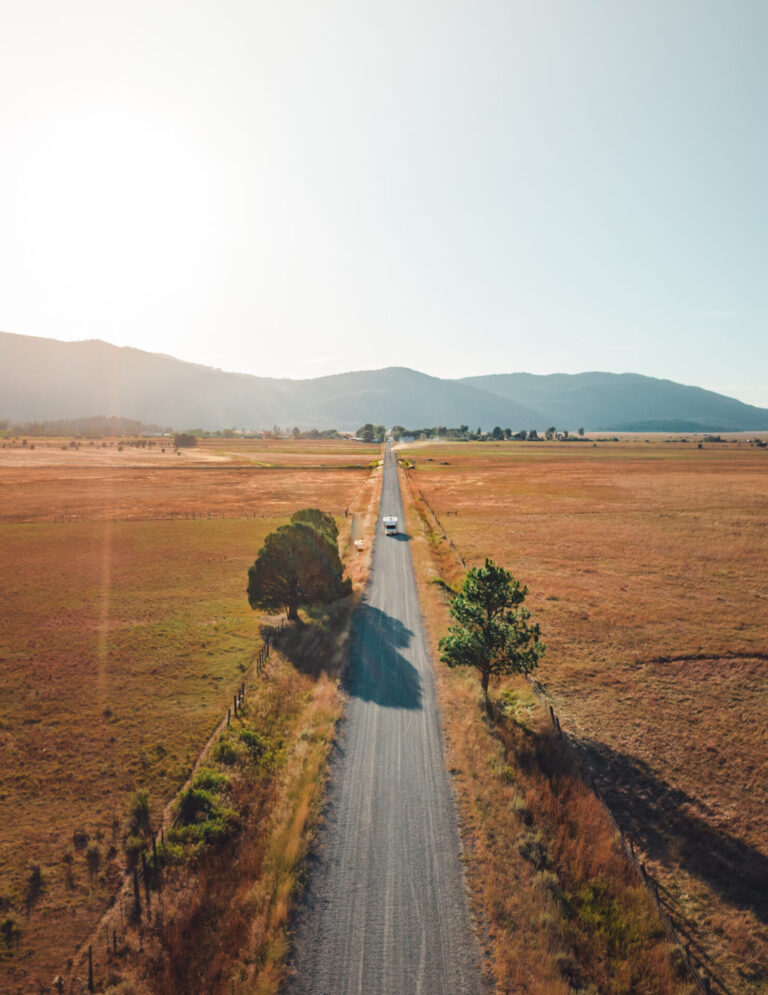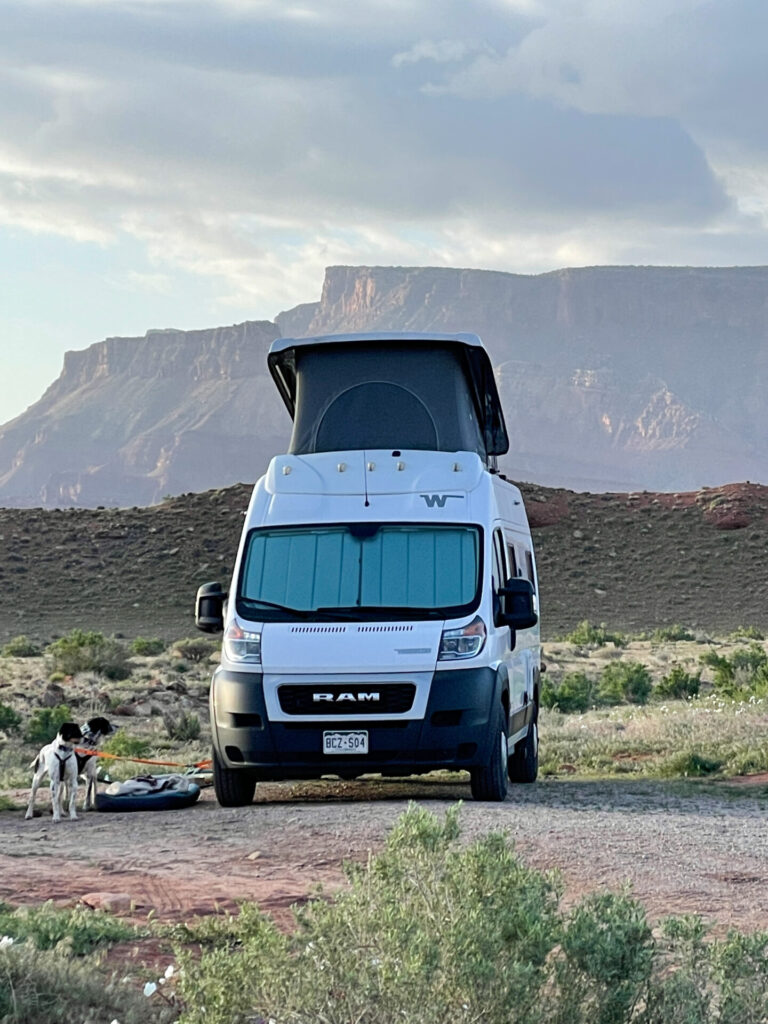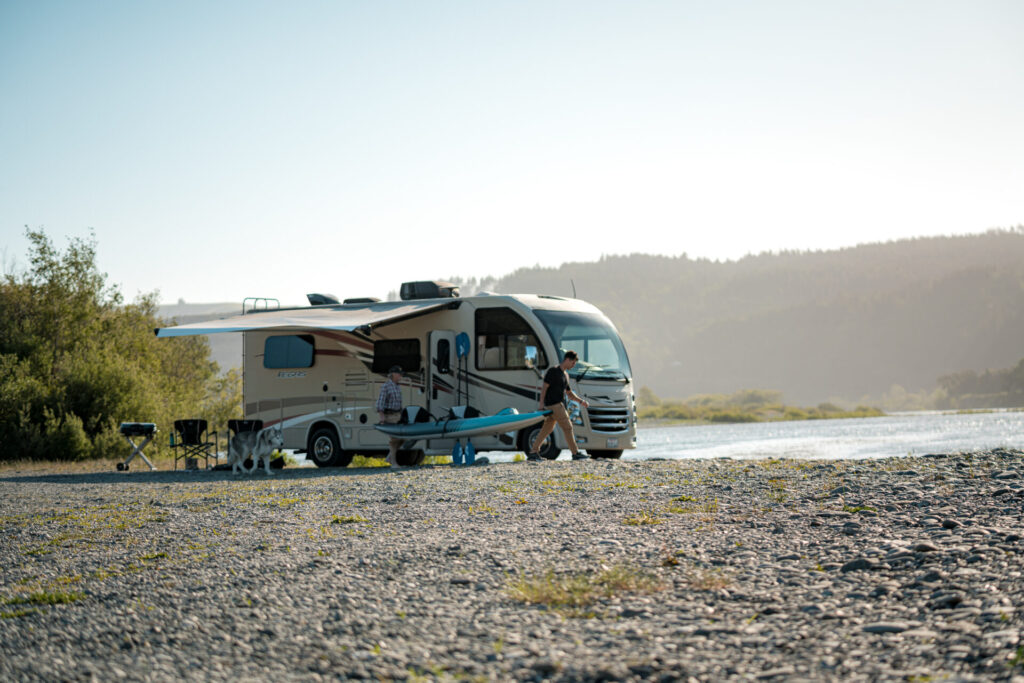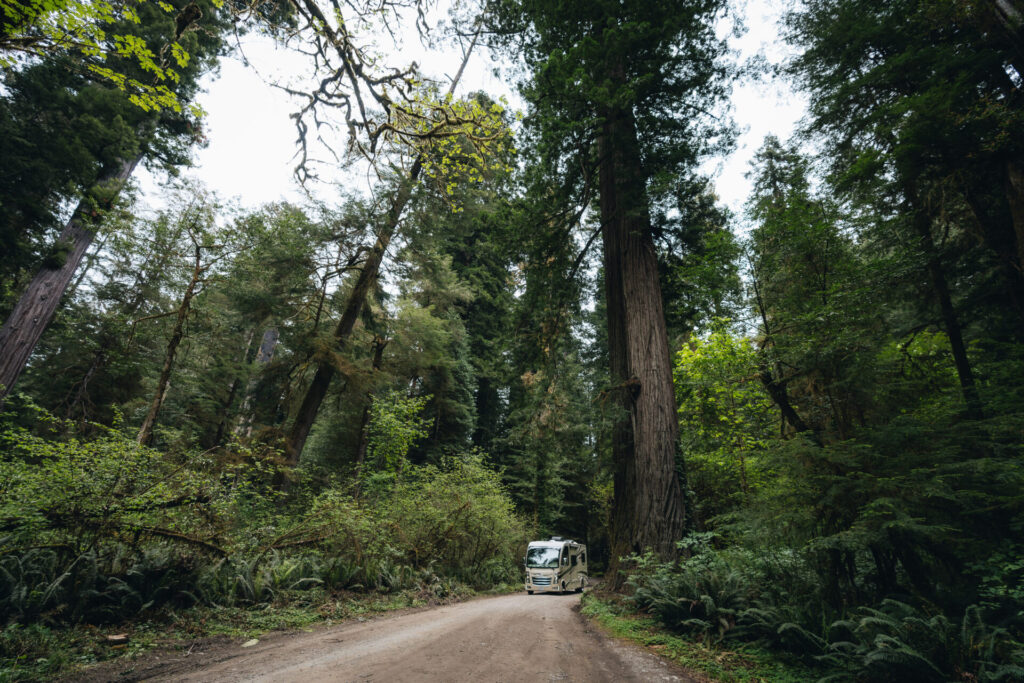
While even a weekend getaway is rewarding in an RV, there’s nothing quite like tackling a coast-to-coast, cross country RV trip road trip! Whether you’re taking Route 66 or meandering I-10 for as long as it’ll carry you, RVing across America is a one-of-a-kind, unforgettable experience for you and your family.
But a cross country RV trip is no simple feat. Although traveling by RV may be more convenient and comfortable than stopping in a series of hotel rooms, unpacking and repacking your bags every time you stop, it still takes some planning chops if you want to pull it off without a hitch. (Or, you know, with a hitch, if you’re in a travel trailer).
So in this post, we’ll walk you through some of our best tips for those taking to the road for a major trek, including how to route your trip, how to plan your stops, and what on earth to bring for the occasion.
Reasons for Renting an RV for a Cross Country Trip
If you’d like to RV across the country, renting a rig could not only give you more flexibility for your travels but could also help you to save money. Traveling in an RV also gives you the opportunity to enjoy the comforts of home, including the ability to prepare your own meals. When traveling for long periods of time, such as on a cross country trip, this can prove to be quite cost-effective.
Furthermore, you can avoid being crammed into a passenger vehicle. Instead, everyone has ample room for stretching out and getting comfortable.
Playing RV Trip Planner? Here’s What You Need to Know
Playing RV road trip planner is a job that’s simultaneously rewarding and overwhelming. It can be a pretty sizable job to route a cross country trip, and an RV trip planner generally works for free.
Going in armed with some pro tips and tactics can go a long way toward turning this chore into a joy, however. Here’s what you should keep in mind when taking on a seriously long-term trip.
1. Don’t overburden yourself with super-long driving days.
Even if you love driving, being on the road for hours on end can be tiresome — especially when you’re driving a larger vehicle, like a motorhome or travel trailer. While everyone’s maximum drive day is different, we recommend figuring out how much driving you can do in a day without feeling overburdened, and sticking to that length of time (or less) when you’re routing out your trip.
For instance, say you’re traveling from Jacksonville to San Diego along I-10. That’s a drive of about 2,300 miles and 33 total hours — which you definitely don’t want to make in one fell swoop. Instead, you’ll probably want to take it in 6-7 hour chunks, making for about a week of travel… and that’s before you factor in the time you need to explore the stops you make along the way.
It’s usually a good idea to have some sense of where you’ll stop, but you also don’t want to lock yourself into anything entirely. Which brings us to the next item on our list…

2. Build in wiggle room.
When you’re planning a super long trip, it’s easy to trick yourself into thinking you’ll be super high energy the entire time, up for whatever comes next on your itinerary. But the truth is, even when we’re doing fun stuff, we do eventually get tired… and your vacation will be much more enjoyable if you have room to sit back, relax, and breathe from time to time.
Although you can run into trouble finding room at developed campgrounds during the most popular travel seasons, you can usually find a spot for a night or two even if you’re making reservations last minute. We recommend not nailing down all of your reservations ahead of time. Rather, use Google Maps (or your RV route planner of choice) to scope out the itinerary, and make a list of cities and sights you’re considering. Then, play it by ear along the way, giving yourself the opportunity to stay a few days at that cool Bohemian town or to skip the expensive spot that sounded better than it actually turned out to be. One of the best parts of RVing is the ability to be spontaneous, so take advantage!
3. Use apps to your advantage.
Speaking of things to use to your advantage, we also recommend using the technology that’s available to help make your trip-planning venture easier. There are free map services like Google Maps and Waze, of course, but we also suggest using programs like RoadTrippers, which can alert you to attractions along the way you might not otherwise have known about.
Apps can help you do a whole lot more than just plan your trip, too: they can help you save money, learn more about the attractions you’re visiting, and so much more.
4. When it comes to stays, think about how long you’ll be there — and your ideal kind of camping trip.
As you probably already know, there are a variety of different kinds of campgrounds out there. And the experience of boondocking on public lands is considerably different than the experience of pulling into a swanky, luxury-filled, developed campground.
That said, if you’re staying at developed campgrounds for the entirety of your trip, you’re going to be spending a fair amount on accommodation fees, which you may want to offset with a few nights of “roughing it.” (Though we have to say, waking up with a view of a beautiful, natural space out your RV window isn’t exactly our idea of a bad time.)
It might be worth investing in amped-up digs if you’re going to be hanging around a place for a longer period, since you’ll probably have better access to amenities like laundry facilities and WiFi. Campgrounds also tend to charge lower per-night prices for folks who are staying a full week or more… though you can always save a good chunk of cash at a wide variety of campgrounds across the country by buying into a Passport America membership. (Get an automatic 50% off at all participating campgrounds!)

Even More Tips for RV Route Planners
RV maps and routes are one thing, but there’s more that goes into creating an enjoyable cross country getaway. Don’t forget about these factors!
5. When it comes to packing, less is more.
We understand the impulse to bring everything but the kitchen sink when you’re taking a cross country trip. (And heck, in most RVs, the kitchen sink is included, too!)
But even the largest motorhomes and travel trailers have pretty limited storage space, which means every single item you bring should be important.
You need clothing and food, of course, but probably not as much as you think. As far as groceries, you can always buy them as you go. We find that overpacking is one of the most common beginner mistakes when it comes to RVing.
When renting an RV, check to make sure the vehicle comes with everything you need, such as dishes, bed linens, towels, etc. This can vary among rentals. Depending on your rental, you may need to pay an additional fee to add on such options if you’re not bringing your own.
6. Bringing Fido? Make sure to keep his needs in mind, too.
Many RVers who take long-term, cross-country trips want to bring their four-legged family members, too. We totally get it! But traveling with pets does add an extra layer of complication, so be sure you’re prepared for the realities of pet-friendly travel.
For one thing, you’ll need to call ahead to the campgrounds you’re considering to ensure they allow dogs (or cats). While most do, some do not.
And be sure not to leave your pet’s needs off your packing list: food dishes, treats, and other items may be necessary to ensure your pet’s comfort for the trip.
7. Don’t want to drive both ways? Don’t worry — you might not have to!
Crossing the country one time is a fun adventure, but doing it twice is… well, kind of a lot, especially if you have to take the same route. And if you’re considering renting an RV through the peer-to-peer market, you may be worried that you need to return it to its owner. But fortunately, that’s just not the case!
RVshare recently rolled out a one-way rental feature, which allows renters like you to drop off their rental vehicles at another location. Then, you can fly home (or make other arrangements) while we drive the RV back to its rightful owner. This saves you money and gives you as much time as possible to fully explore on the way out. Win-win!
Mistakes to Avoid When Renting an RV for a Cross Country Trip
Be sure to avoid some of the more common mistakes when you embark on your cross country trip. Many people make the mistake of thinking they should rent the biggest RV possible for a long trip. In reality, you might find it’s better to rent a smaller vehicle as long as it accommodates the number of people traveling with you. A smaller RV is usually easier to handle, especially when traveling on mountain overpasses or narrow, twisting roads. Additionally, a smaller RV can perform better on open highway stretches, where strong winds could push around your RV.
Another common mistake is not taking the time necessary to get to know the vehicle before you set out on your trip. Don’t make the mistake of thinking you’ll figure it out as you go. Take a few minutes to practice driving around the parking lot, reading the vehicle manual, and asking any necessary questions before you start your trip.
Best RV Rental for a Cross Country Trip
It’s essential to make sure you choose the best RV rental for a cross country trip. While there are many different types of rigs to choose from, many are more appropriate for shorter trips. For a long road trip, there are essentially two choices. They are fifth wheels and motor homes. With a motorhome, you have the benefit of a steering wheel and a driver’s area inside the vehicle. If you need to access the rest of the RV, you can do so without getting out of the vehicle. You can also tow a car behind a motorhome. By comparison, a fifth-wheel hooks into the bed of a pickup truck. This means that in order to access the living quarters, you’ll need to get out of the vehicle you’re using to pull the trailer and enter from the outside.
Lots of RV Types to Consider
Bear in mind that the type of RV you choose for your cross country trip will significantly impact the comfort of your travels. By driving a motorhome, you will be able to tow another vehicle, giving you more transportation options. Since a fifth-wheel is connected to the truck you drive, you have only that vehicle as your transportation. A fifth-wheel is generally more expensive to rent, and if you don’t have a truck to pull it you’ll need to rent that as well. It’s also important to consider size. Not all motorhomes are the same size, and some are longer than a fifth-wheel, which could make it hard to find a campsite that fits.
When budgeting for a cross country RV trip, be aware that RVs typically rent on daily as well as weekly rates. It’s important to be sure of the rental terms before booking your RV. The terms of the rental may vary based on the company where you’re renting the rig. Some rental companies require that you pay the entire rental fee upfront along with a deposit.

RV Rental Options
One option for renting an RV for your cross country trip would be to rent from a dealer, but you might also wish to consider renting directly from an RV owner. Sites like RVshare.com make it easy for prospective renters to get in contact with RV owners who rent out their rigs when they aren’t using them. Renting from an owner directly can provide a range of benefits, including the option to rent a fully loaded RV for much less money than you might expect. Remember, when renting an RV to drive cross country, make sure that you and your passengers will be comfortable both on the road and when it’s time to sleep. Don’t be afraid to inspect it and ask questions.
With some proper planning and research, renting an RV for your next cross country trip could provide you with a vacation of a lifetime. While a cross country RV trip can be expensive, if you plan wisely, cook your meals, and find a good deal on an RV, you can have fun on the cheap.
RV Cross Country Driving Routes
Seriously considering a cross country road trip? There are a variety of different routes you can take, from the iconic Route 66 to the highly underrated I-70.
But no matter which way you go, we know you won’t regret your time spent en route when you’re hitting the road in an RVshare vehicle!
This post may contain affiliate links.

